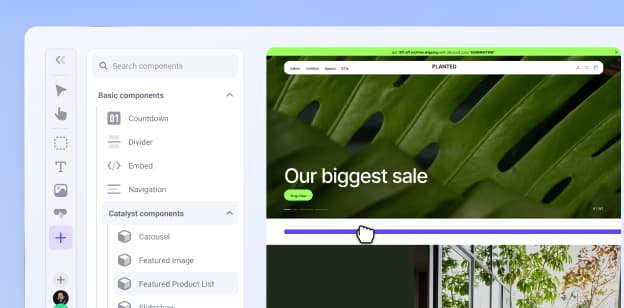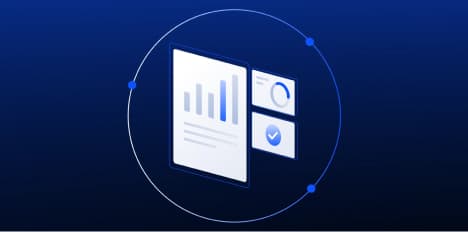Wholesale Ecommerce: Types, Trends, and What to Look for in an Ecommerce Platform

Written by
Haylee Clark26/12/2025

Key highlights
Wholesale ecommerce refers to selling products in bulk online to other businesses, distributors or resellers, often with custom pricing and purchasing terms.
A successful wholesale ecommerce strategy requires tailored pricing structures, flexible order minimums and streamlined workflows that reflect B2B buying behaviors.
Wholesale ecommerce platforms should support robust account management, negotiated pricing, quick reorders and scalable integrations with ERP and fulfillment systems.
Effective wholesale ecommerce enhances customer relationships, increases order value and reduces friction in complex purchasing processes.
Combining wholesale ecommerce with direct-to-business digital tools and automation enables brands to grow revenue while serving larger, more sophisticated buyers.
For years, ecommerce was seen as the domain of consumer brands. But today, wholesale businesses are just as invested in going digital — and for good reason.
Modern B2B buyers expect the same convenience, transparency, and self-service options they’re used to as consumers. They don’t want to fax purchase orders, chase down invoices, or wait on hold with a sales rep just to reorder a product. They want to log in, see their custom pricing, and complete a transaction quickly and confidently.
Wholesale ecommerce makes this possible. By selling products online in bulk at discounted rates, wholesalers can streamline operations, expand into new markets, and strengthen customer relationships, all while keeping pace with competitors who are already moving online.
And the growth opportunity is massive. According to Insider Intelligence, B2B ecommerce will account for 27.5% of online sales and 14.3% of total B2B product sales by 2028 — up significantly from 2024. Wholesale is no longer a side channel; it’s becoming the backbone of how business buyers purchase.

Ebook: B2B Digital Maturity Guide
Discover your maturity level as a B2B storefront and learn how you can improve.
Wholesale vs. B2C ecommerce
At its core, the difference between wholesale and retail ecommerce comes down to scale and audience.
B2B wholesale focuses on selling large quantities of goods at lower per-unit prices to other businesses. These buyers may be retailers, manufacturers, or distributors who need to resell, assemble, or redistribute products. B2C, on the other hand, is about selling smaller quantities directly to end consumers.
But beyond volume, the differences run even deeper:
| Wholesale ecommerce | Retail (B2C) ecommerce |
Pricing | Negotiated, volume-based discounts. Low unit cost is critical for margins. | Fixed, listed pricing. More flexibility to adjust per consumer demand. |
Marketing | Focused on profitability through bulk orders and cost-efficient online presence. | High spend to attract and retain individual customers. Heavy focus on branding. |
Competition | Less saturated markets, more opportunities to specialise. | Highly competitive, with many players in crowded markets. |
Location | Typically less dependant on physical location. Can sell across regions and industries. | Location is often critical (e.g., storefront visibility, foot traffic). Can be costly. |
Fulfilment | Primary focus. Streamlining is key to success. | One element of operations, with greater emphasis on marketing and customer engagement. |
Pricing.
Wholesale: Because wholesalers buy in significant quantities, success depends on negotiating the lowest per-unit cost. Margins come from volume.
B2C: Often have more pricing flexibility since they’re targeting consumers directly. Retailers adjust based on brand positioning, not just bulk purchasing.
Marketing.
Wholesale: Focused on efficiency and cost savings. Marketing is less about brand storytelling and more about making ordering easy and reliable.
B2C: Heavy investment in consumer marketing to stay top-of-mind in crowded markets.
Competition.
Wholesale: Can choose from a large array of products and markets to target. As long as businesses are interested in bulk purchases, wholesalers will have a market.
B2C: Often saturated and cutthroat, requiring strong differentiation, unless offering a truly unique product.
Location.
Wholesale: Not tied to local markets; they can sell wherever there are businesses in need.
B2C: Location is critical, especially for retailers with brick-and-mortar stores. Retailers must be where consumers are, whether on a high-traffic street or inside a mall.
Fulfilment.
Wholesale: Warehousing, shipping, and logistics are the heart of the business. Efficiency = profit.
B2C: Fulfilment is one function among many, often secondary to marketing and branding.
The main types of wholesalers
Not all wholesalers operate the same way. Understanding the main models can help you identify the right partnerships or decide which strategy works best for your own ecommerce business.
Manufacturers.
These are businesses that create finished products from raw materials. While many sell directly to distributors or retailers, some manufacturers also act as their own wholesalers, offering bulk discounts to move large volumes quickly.
Example: In the automotive industry, a car parts manufacturer sells fuel pumps and engines directly to auto companies that assemble and resell complete vehicles.
Merchant wholesalers.
Perhaps the most traditional form of wholesale, merchant wholesalers purchase finished products in large quantities, store them, and resell them to other businesses. They take ownership of the goods and handle distribution.
Example: A clothing wholesaler buys 10,000 t-shirts from a manufacturer, stores them in a warehouse, and resells them in smaller lots to fashion boutiques.
Agents/brokers.
Unlike merchant wholesalers, agents and brokers don’t take ownership of inventory. Instead, they serve as intermediaries who bring buyers and sellers together and earn commissions on the deals they facilitate.
Example: A broker in the produce industry negotiates between a farm co-op and grocery chains, ensuring both sides get favourable terms.
Import/export.
These wholesalers specialise in international trade, navigating customs regulations, tariffs, and shipping logistics to move products across borders. They make it possible for businesses to expand into new global markets without the complexity of setting up operations abroad.
Example: An import/export wholesaler brings in electronics from South Korea and resells them to US-based ecommerce retailers.
How wholesalers can benefit from ecommerce
Wholesale was once dominated by handshakes and phone calls. Now, B2B order management is digital, and the benefits are clear.
According to the International Trade Administration, over 90% of B2B businesses have moved to an ecommerce sales model since 2020, largely due to “improved process efficiencies and improved managing software.”
Here are some of the biggest reasons wholesalers are embracing ecommerce:
Meet buyers where they are.
Modern buyers don’t limit themselves to one purchasing method. They discover new products on online marketplaces, compare options on social media, and place bulk orders directly through supplier websites. An ecommerce platform gives wholesalers the ability to show up in all these places at once — creating a seamless, omnichannel experience that matches the way customers actually shop.
Increase revenue without increasing overhead.
Digitising wholesale operations often leads to dramatic revenue growth. That’s because ecommerce platforms let businesses scale sales without adding more sales reps or expanding physical locations.
Take TYGRIS, for example: after moving online, the company reported a 138% increase in revenue — proof that digital tools don’t just reduce costs, they actively drive growth.
Read the full TYGRIS case study here.
Automate manual tasks.
In the traditional wholesale model, processing orders, sending invoices, and updating stock levels could take hours of manual work. B2B ecommerce platforms automate these repetitive tasks, from quote-to-order workflows to reordering and invoicing. More than just saving time, this frees sales teams to focus on building stronger relationships and pursuing bigger, more strategic accounts.
Make smarter, data-driven decisions.
One of the biggest advantages of ecommerce is visibility. Platforms track what buyers are purchasing, when they reorder, and even where they abandon their carts.
With these data insights, wholesalers can refine their catalogues, adjust pricing strategies, and better anticipate customer needs. Decisions become proactive instead of reactive, and that translates into healthier margins and happier customers.
Expand into global markets.
Selling internationally used to require offices abroad, local distributors, and complex supply chain management. Ecommerce removes many of those barriers.
With the right platform, wholesalers can launch cross-border storefronts, offer localized pricing, and partner with logistics providers to handle customs and shipping. The result? A global footprint without the global overhead.
What to look for in a wholesale ecommerce platform
Not all ecommerce solutions are built for the demands of wholesale. While a standard B2C platform might work for a small shop selling directly to consumers, wholesalers face very different challenges: bulk orders, account-specific pricing, complex integrations, and global scalability.
Here are the most important factors to evaluate:
Budget alignment.
The cost of an ecommerce platform isn’t just the subscription fee. You’ll want to factor in setup costs, ongoing maintenance, and the expense of future upgrades or integrations. A platform should match your budget not only today but also as you grow, so you’re not forced into an expensive replatforming project two years down the line.
Extensive, open integrations.
Wholesalers often rely on a sophisticated tech stack that includes ERP, CRM, PIM, and POS systems. Your ecommerce platform should connect seamlessly with those tools, ideally through open APIs and pre-built integrations. This reduces friction across your operations and ensures your systems are always in sync.
SEO and marketing capabilities.
Even wholesalers need to be discoverable online. Strong SEO features ensure your ecommerce site ranks when buyers are searching for products in your category. Content marketing tools, like blogging capabilities or landing page builders, also help wholesalers establish thought leadership and attract new customers.
Advanced catalogue and search functionality.
Wholesale catalogues can be massive, with thousands of SKUs, multiple variations, and custom pricing rules. That means your platform needs to not just display products, but give wholesale buyers the tools to quickly find exactly what they’re looking for, no matter how complex the catalogue.
The best wholesale ecommerce platforms allow you to:
Build account-specific catalogues that show only relevant products to each customer segment.
Offer custom pricing tiers and volume discounts that align with negotiated contracts.
Enable faceted search and filtering so buyers can drill down by attributes like size, weight, or colour.
AI-powered search is also becoming a game-changer for wholesalers with large catalogues. Solutions like Klevu use natural language processing to understand buyer intent and deliver hyper-relevant results.
Flexible payment options.
B2B transactions look very different from consumer checkouts. Beyond credit cards, your platform should support ACH transfers, purchase orders, net terms, and even Buy Now, Pay Later solutions. By offering multiple payment methods, you remove friction from the purchasing process and make it easier for customers to place large, high-value orders.
Real-world wholesale ecommerce success storeys
These wholesale brands needed cutting-edge technology and flexible APIs to get the job done — and they found their solution in BigCommerce.
AS Colour.
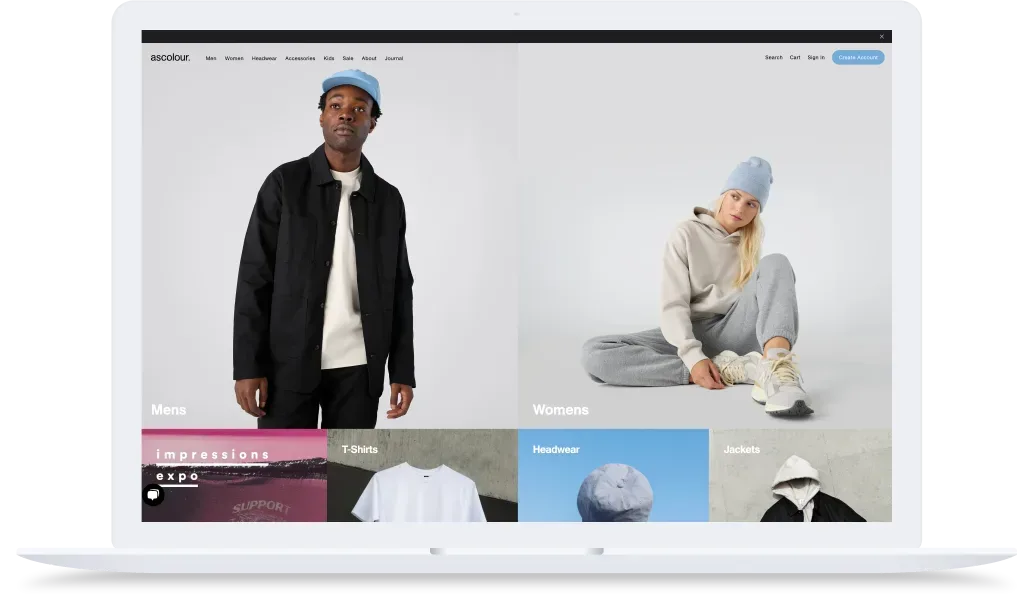
AS Colour built its reputation on creating long-lasting, high-quality basics. But to match their product quality, they needed a digital storefront that could handle both wholesale and direct-to-consumer sales across global markets.
By migrating to BigCommerce, AS Colour gained the flexibility to run B2B and DTC operations under one roof. With features like Multi-Storefront and robust APIs, the brand expanded globally while keeping customer experiences frictionless.
Key results:
51% increase in visits
39% increase in orders
45% increase in revenue
The Beer Bat.
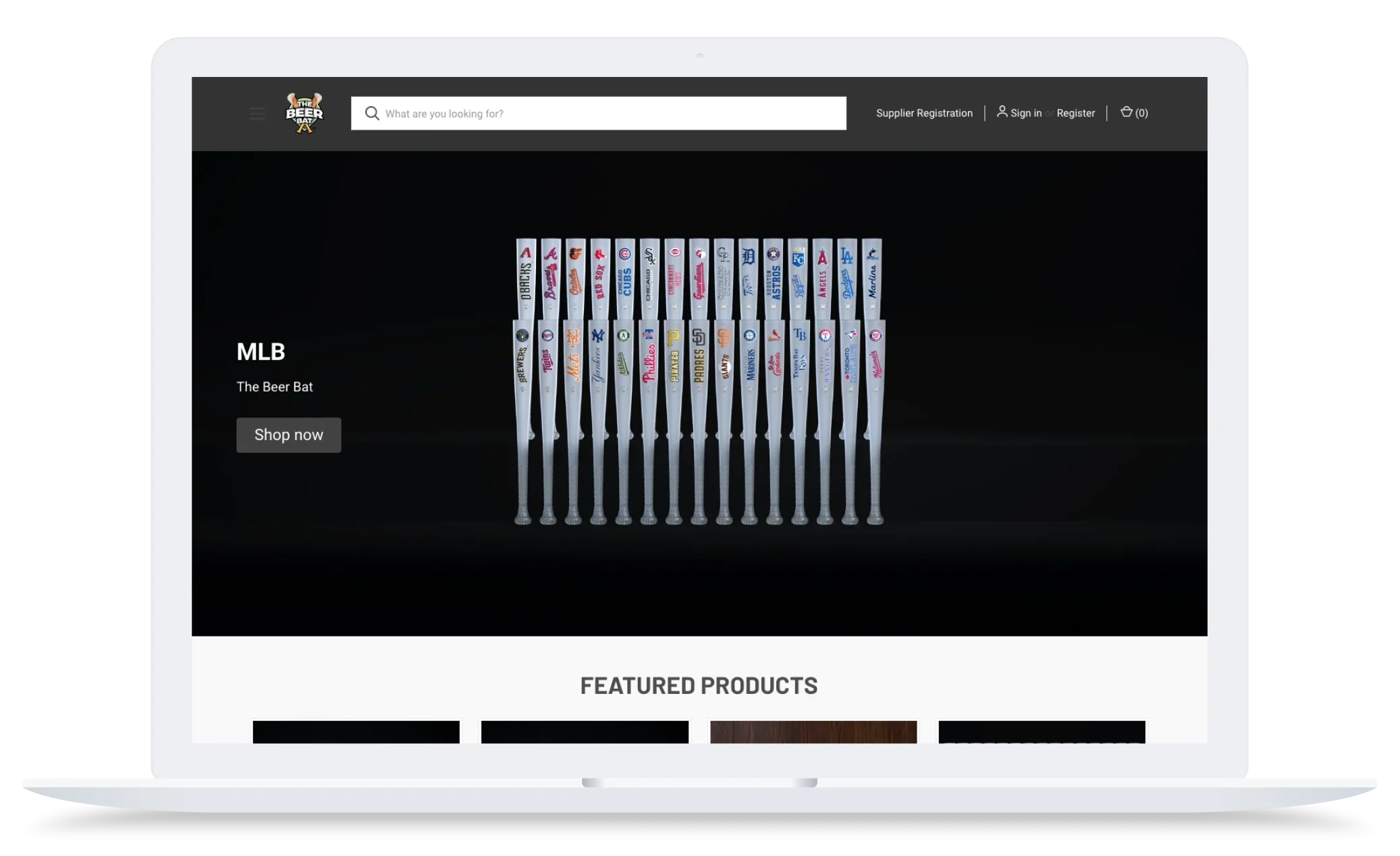
Known for its novelty baseball-bat-shaped mugs, The Beer Bat was already a fan favourite among consumers. But as demand grew, so did the need to manage wholesale and retail simultaneously — without overwhelming the team.
With BigCommerce’s B2B Edition, The Beer Bat streamlined wholesale order management, making it simple for distributors and retailers to place large orders. At the same time, Multi-Storefront gave the brand the ability to expand internationally without the hassle of running multiple back-end systems.
Key results:
71%increase in orders
98%increase in site visits
115% increase in revenue
Toolsaver.
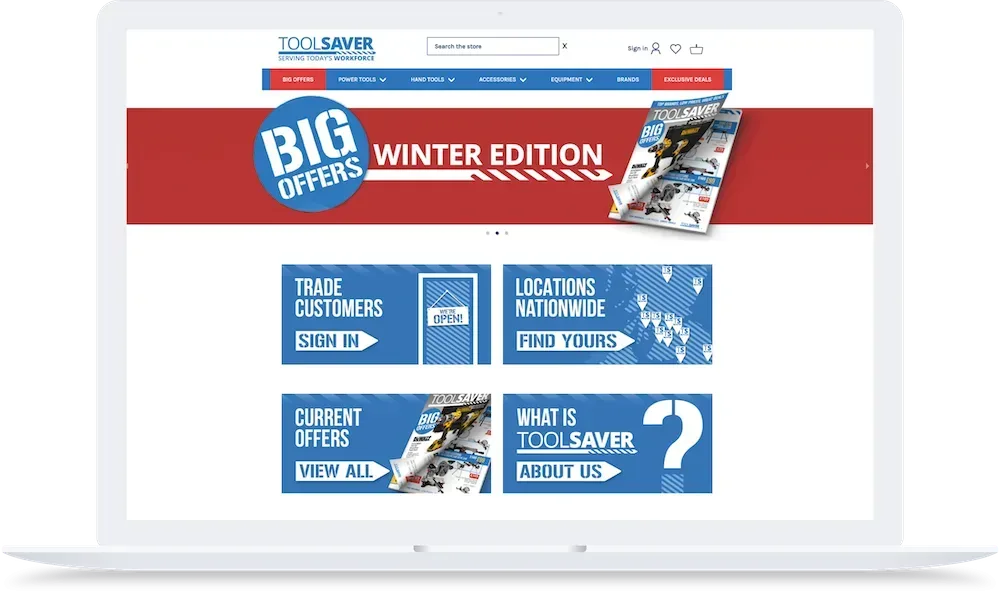
Toolsaver serves customers who rely on having the right tool at the right time, which means order accuracy and operational efficiency are non-negotiable. But with previous vendors, the company struggled with functionality gaps and integration headaches.
By switching to BigCommerce, Toolsaver tapped into the power of open APIs and seamless integrations. Using Feedonomics, they could sell across Amazon, Google Shopping, and Instagram while managing every order in one place. The result? Omnichannel reach without added complexity.
Key results:
19.9% increase in orders
23.5% increase in revenue
3% increase in AOV
Emerging trends shaping wholesale ecommerce
Wholesale ecommerce is evolving quickly. New technologies, shifting buyer expectations, and global market forces are shaping how wholesalers operate — and where opportunities lie. Here are the key trends transforming the industry now.
AI-powered search and recommendations.
Artificial intelligence in B2B ecommerce is no longer just a buzzword. It’s becoming a core driver of the wholesale buying experience. Modern AI search tools can interpret buyer intent, not just keywords, and serve up more accurate, personalised product recommendations.
Yet, adoption is still early. A NuOrder report found that only 24% of wholesalers currently use AI to improve buyer experience. That means there’s a big opportunity for early adopters to differentiate themselves by making product discovery faster and smarter.
Self-service B2B portals.
Millennials and Gen Z now make up the majority of B2B buyers, and they expect the same autonomy they enjoy when shopping personally. That’s why 24/7 self-service portals are becoming essential.
These portals allow wholesale customers to:
Access personalised pricing
Manage their accounts on their own terms
Place repeat or bulk orders without sales rep involvement
The result? Faster, easier transactions and happier customers.
Omnichannel commerce: Blending B2B and DTC.
The line between wholesale and retail is blurring. Many wholesalers are running both B2B and DTC operations, and the most successful ones are blending the two seamlessly.
With solutions like BigCommerce’s B2B Edition, wholesalers can manage negotiated bulk orders alongside consumer transactions, all on a single platform. This approach reduces operational risk, diversifies revenue, and keeps the brand competitive across multiple channels.
“Because we have the DTC and B2B sides of the business, we really needed a website that had the look and feel of a retail site, while also providing that B2B functionality,” said Joe Sharplin, Head of Ecommerce at AS Colour. “BigCommerce is perfect in that aspect.”
Sustainable and transparent supply chains.
Sustainability is no longer optional. Over half of wholesalers (54%) report they are actively improving sustainability efforts, from eco-friendly products to greener packaging.
But it’s not just about being environmentally responsible. Buyers increasingly demand transparency about where and how products are sourced. Wholesalers who prioritise supply-chain visibility and sustainable practises will be better positioned to win long-term trust.
Why wholesalers choose BigCommerce
Wholesale ecommerce isn’t one-size-fits-all. You need a B2B ecommerce platform that can flex to your workflows, integrate with your existing systems, and scale with your growth. And that’s exactly why leading wholesale brands choose BigCommerce.
BigCommerce B2B Edition: Purpose-built for wholesalers.
Our B2B Edition equips you with enterprise-grade functionality designed specifically for wholesale commerce:
Advanced buyer portals: Custom catalogues, price lists, and reordering tools.
Flexible account management: Segment buyers with tiered wholesale prices, volume discounts, and personalised access.
Streamlined order management: From RFQ (Request for Quote) to checkout, make it effortless for buyers to place orders online.
With features like shared shopping lists, invoice portals, and support for complex B2B orders, BigCommerce gives your buyers the modern experience they expect.
Discover all the benefits of BigCommerce B2B Edition.
Partner integrations that scale with you.
Wholesalers don’t operate in a silo. That’s why BigCommerce offers best-in-class partner integrations for every part of your business:
ERP & accounting: Seamless connections with systems like NetSuite ensure real-time inventory management and financial syncing.
POS & multi-channel: Sync your offline and online sales, so whether buyers find you at a trade show, a brick-and-mortar store, or your ecommerce website, their orders flow through one system.
Marketing & sales tools: From reordering reminders to personalised campaigns, our ecosystem supports your growth at every stage.
Security and scalability you can trust.
Running on Google Cloud with 99.99% uptime, PCI DSS compliance, and a global CDN, BigCommerce ensures your wholesale store performs under pressure. Whether your buyers are placing orders from New York, Singapore, or London, speed and reliability are never in question.
Modern buyer experience.
Give your B2B buyers the same intuitive digital experience they enjoy as consumers with straightforward navigation and a streamlined buyer experience.
With customised pricing and product access for different customer segments, buyers can find what they need at rates that meet their unique business requirements.
The final word
The wholesale industry is at a turning point. By moving operations online, wholesalers can streamline ordering, strengthen customer relationships, and unlock new opportunities across global markets.
The good news is that moving to ecommerce is easier than you think. With the right platform and strategy, wholesalers can create an online presence that matches their offline capabilities and enhances them through automation, better data insights, and improved personalised experiences.
FAQs about wholesale ecommerce
Personalisation is just as important in B2B commerce as it is in retail. Buyers expect an experience that feels tailored to their needs, not one-size-fits-all. Businesses can personalise the wholesale buying journey by offering:
Custom pricing tiers based on account type or order volume.
Exclusive catalogues that only show products relevant to each buyer.
Tailored marketing, such as reorder reminders or promotions based on purchase history.
Customer-specific portals with unique dashboards and order histories.
Data-driven recommendations powered by analytics to suggest the right wholesale products at the right time.
Shifting from trade shows, phone calls, and paper invoicing to a digital-first model can be intimidating. The most common challenges include:
System integration: Syncing inventory, accounting, and ERP systems.
Employee adoption: Training teams to use new digital workflows.
Data security: Protecting sensitive B2B order and payment information.
The solution? Choose a scalable B2B ecommerce platform that integrates with your existing systems, prioritise hands-on training for staff, and establish strong cybersecurity protocols from the start.
Selling to both consumers and businesses creates resilience. By diversifying your revenue streams, you can:
Expand your market reach: Reaching shoppers and bulk buyers at once.
Optimise margins: Leverage economies of scale with larger production runs.
Protect against risk: You’re not reliant on a single sales channel or customer type.
Many modern wholesale platforms, like BigCommerce, make it simple to manage both B2C and B2B commerce on the same storefront.
Wholesale ecommerce is the online sale of products in bulk and at wholesale prices to other businesses. Instead of acting as a direct-to-consumer retailer, wholesalers serve as the bridge between manufacturers and distributors or resellers, providing inventory at scale.
Not exactly. Wholesale ecommerce is a type of B2B commerce, but not all B2B companies are wholesalers. For example, a software provider selling licences to a business is B2B, but not wholesale. Wholesale specifically involves purchasing bulk physical products from manufacturers to resell.
Finding the right vendor takes a little research. Here’s a simple five-step process:
Decide on your product line. Know what you want to sell before you start searching.
Understand distribution channels. Learn whether your industry relies on direct manufacturers, merchant wholesalers, or brokers.
Cheque online directories. Platforms like Alibaba, ThomasNet, or trade association directories can connect you with vetted vendors.
Contact manufacturers directly. Sometimes you’ll find the best wholesale prices at the source.
Reach out and compare. Start conversations, request samples, and evaluate terms before choosing a partner.
At a minimum, look for a platform that offers:
Custom and tiered pricing
Bulk order forms
Quote management workflows (RFQs)
Personalised catalogues by account
Flexible payment methods (credit, ACH, net terms, etc.)
Seamless ERP and CRM integrations
The right solution depends on your audience:
B2C platforms are built for fixed-price, single-item purchases and prioritise branding and marketing.
B2B ecommerce platforms are designed for complex, high-volume orders, custom pricing, negotiated quotes, and multi-channel reordering.
If you serve both, look for a commerce platform (like BigCommerce) that supports hybrid selling so you can manage DTC and wholesale under one roof.
Future-proofing means building for growth, not just for today. Wholesalers should:
Choose a scalable SaaS platform that can handle traffic spikes and order surges.
Prioritise open APIs to integrate with emerging technologies (AI, AR, etc.).
Support an omnichannel strategy that blends B2B, B2C, and marketplace sales.
Automation is the backbone of efficient wholesale operations. It reduces manual errors, accelerates fulfilment, and frees sales teams to focus on high-value relationships.
Examples include:
Automated RFQ-to-order workflows
Inventory and catalogue syncing
Billing and invoicing automation
Reorder reminders for repeat customers
The result? Faster order cycles, lower operational costs, and a better buying experience for your B2B customers.

We're serious about B2B.
BigCommerce B2B Edition gives you account management and quoting tools to help your sales team get more orders.
